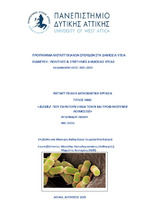| dc.contributor.advisor | Mandilara, Georgia | |
| dc.contributor.author | Αυγερινίδου, Λιθαρή | |
| dc.date.accessioned | 2023-10-20T13:07:17Z | |
| dc.date.issued | 2023-09-27 | |
| dc.identifier.uri | https://polynoe.lib.uniwa.gr/xmlui/handle/11400/5425 | |
| dc.identifier.uri | http://dx.doi.org/10.26265/polynoe-5262 | |
| dc.description.abstract | One of the most important emerging foodborne infections that constitute a major public health
problem worldwide, are those caused by strains of the bacterium Escheichia coli that produce
Shiga toxins (Stx) (Shiga toxin - producing E.coli- (STEC), the pathogenic action of which is
enhanced-determined by additional virulence factors, with the symptomatology of the resulting
infection ranging from mild diarrhea to severe and sometimes fatal complications, most notably
hemolytic uremic syndrome (HUS), and end-stage renal disease (ESRD). Although cattle and
other ruminants are considered the main reservoirs of STEC, strains of STEC have now been
isolated from other animals as well. Therefore, the source of contamination extends to a wide
range of foods, not only beef products but also fresh produce, water, unpasteurized dairy
products, fruits and vegetables, which are contaminated by animal excreta. As modes of
transmission of STEC include direct contact with vectors and a variety of environmental
exposures, it is necessary to approach the problem from a holistic health perspective that will
involves collaboration between scientists from different fields to better understand the different
routes of STEC transmission and develop effective control measures to anticipate/treat all
potential sources of contamination. The possibility of causing epidemics, the increasing tendency
of the prevalence of the disease, the appearance of emerging serotypes, but also the financial
burden of managing the disease require an optimal approach and management, with the study
and understanding of new epidemiological data, the use of modern diagnostic methods, the
continuous and effective surveillance, in order to implement correct prevention and control
policies, aiming to minimize the incidence of cases in the future.
This review attempts to update and highlight newer data on the epidemiology and disease
severity of STEC infection, surveillance methods and modern diagnostic methods, highlighting
the need for appropriate control measures to prevent, avoid or at least minimize incidence of
similar cases in the future. | el |
| dc.format.extent | 98 | el |
| dc.publisher | Πανεπιστήμιο Δυτικής Αττικής | el |
| dc.rights | Αναφορά Δημιουργού - Μη Εμπορική Χρήση - Παρόμοια Διανομή 4.0 Διεθνές | * |
| dc.rights.uri | https://creativecommons.org/licenses/by-nc-sa/4.0/deed.el | * |
| dc.subject | E.coli, Epidemic, Foodborne infections, Shiga toxin (STEC), Reservoirs, Transmission, Diagnosis, Treatment, Surveillance, Prevention | el |
| dc.title | "Shiga Toxin producing E.Coli and Foodborne Infections" | el |
| dc.title.alternative | "E. Coli που παράγουν Shiga Toxin και Τροφιμογενείς Λοιμώξεις" | el |
| dc.type | Μεταπτυχιακή διπλωματική εργασία | el |
| dc.contributor.committee | Papadogiannakis, Emmanouil | |
| dc.contributor.committee | Κονταρίνη, Μαριέττα | |
| dc.contributor.faculty | Σχολή Δημόσιας Υγείας | el |
| dc.contributor.department | Τμήμα Πολιτικών Δημόσιας Υγείας | el |
| dc.contributor.master | Δημόσιας Υγείας | el |
| dc.description.abstracttranslated | Μια από τις σημαντικότερες αναδυόμενες τροφιμογενείς λοιμώξεις που συνιστούν μείζον
πρόβλημα δημόσιας υγείας παγκοσμίως , είναι αυτές που οφείλονται σε στελέχη του βακτηρίου
Escheichia Coli που παράγουν τοξίνες Shiga (Stx) (Shiga toxin - producing E.Coli- (STEC), η
παθογόνος δράση των οποίων ενισχύεται-καθορίζεται από επιπρόσθετους παράγοντες
λοιμογονικότητας, με τη συμτωματολογία της προκαλούμενης λοίμωξης να κυμαίνεται από ήπια
διάρροια έως σοβαρές και ενίοτε θανατηφόρες επιπλοκές, με κυριότερο το αιμολυτικό
ουραιμικό σύνδρομο (ΗUS), και τη νεφρική νόσο τελικού σταδίου (ESRD). Αν και τα βοοειδή
και άλλα μηρυκαστικά θεωρούνται οι κύριες δεξαμενές της STEC, έχουν πλέον απομονωθεί
στελέχη STEC και από άλλα ζώα. Ως εκ τούτου, η πηγή μόλυνσης εκτείνεται σε ένα ευρύ φάσμα
τροφίμων, όχι μόνο σε προϊόντα βοείου κρέατος αλλά και σε φρέσκα προϊόντα, νερό,
απαστερίωτα γαλακτοκομικά προϊόντα, φρούτα και λαχανικά, τα οποία μολύνονται από τα
εκκρίματα των ζώων. Καθώς οι τρόποι μετάδοσης του STEC περιλαμβάνουν την άμεση επαφή
με φορείς και μια ποικιλία εκθέσεων που σχετίζονται με το περιβάλλον, είναι απαραίτητη η
προσέγγιση του προβλήματος υπό το πρίσμα της ενιαίας υγείας που θα περιλαμβάνει τη
συνεργασία μεταξύ επιστημόνων από διαφορετικούς τομείς για την καλύτερη κατανόηση των
διαφορετικών οδών μετάδοσης STEC και την ανάπτυξη αποτελεσματικών μέτρων ελέγχου ώστε
να προβλεφθούν/ αντιμετωπιστούν όλες οι πιθανές πηγές μόλυνσης. Η δυνατότητα πρόκλησης
επιδημιών, η αυξητική τάση επιπολασμού του νοσήματος, η εμφάνιση αναδυόμενων οροτύπων,
αλλά και το οικονομικό φορτίο διαχείρισης της νόσου επιτάσσουν τη βέλτιστη προσέγγιση –
διαχείριση του, με τη μελέτη και κατανόηση των νέων επιδημιολογικών δεδομένων, τη χρήση
σύγχρονων μεθόδων διάγνωσης, τη συνεχή και αποτελεσματική επιτήρηση, ώστε να
εφαρμοστούν ορθές πολιτικές πρόληψης και ελέγχου, αποσκοπώντας στην ελαχιστοποίηση της
επίπτωσης κρουσμάτων στο μέλλον.
Η παρούσα ανασκόπηση επιχειρεί να ενημερώσει και να αναδείξει νεότερα δεδομένα ως προς
την επιδημιολογία και τη σοβαρότητα της νόσου από λοίμωξη με STEC, τις μεθόδους
επιτήρησης και σύγχρονες μεθόδους διάγνωσης, υπογραμμίζοντας την αναγκαιότητα λήψης
κατάλληλων μέτρων ελέγχου για την πρόληψη, αποφυγή ή τουλάχιστο την ελαχιστοποίηση της
επίπτωσης αντίστοιχων κρουσμάτων στο μέλλον. | el |
| dcterms.embargoTerms | 6 months | el |
| dcterms.embargoLiftDate | 2024-04-20T13:07:17Z | |



